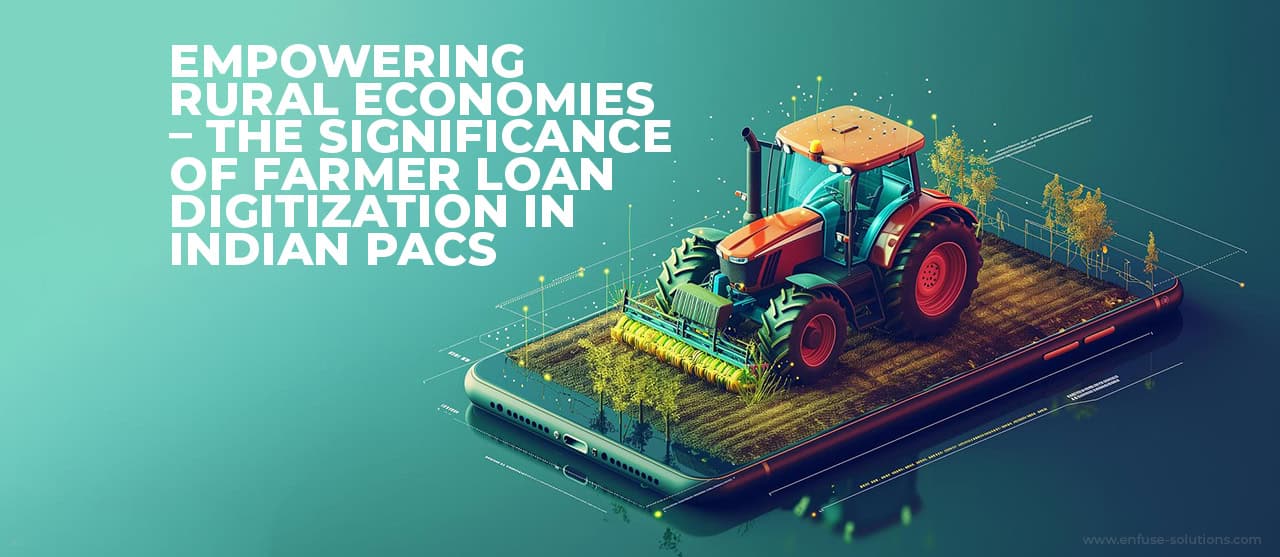
The digitization of farmer loans in India’s Primary Agricultural Credit Societies (PACS) is a transformative step towards empowering rural economies. By integrating digital technologies into the loan disbursement and management processes, PACS can significantly enhance financial inclusion, improve operational efficiency, and foster sustainable agricultural development.
This blog explores the importance and impact of digitizing farmer loans within PACS, supported by market trends and statistics.
The Role Of PACS In Rural Finance
Primary Agricultural Credit Societies (PACS) are grassroots-level cooperative institutions in India that play a crucial role in providing agricultural credit to farmers. They are vital in bridging the gap between formal financial institutions and rural farmers who often lack access to conventional banking services. PACS offers short-term and medium-term loans for agricultural purposes, helping farmers meet their seasonal and developmental financial needs.
The Need For Digitization
1. Enhancing Financial Inclusion
Many farmers in rural India remain unbanked or underbanked. Digitizing loan processes can significantly improve their access to credit. According to a report by the National Bank for Agriculture and Rural Development (NABARD), around 60% of rural households rely on informal sources of credit. Digital platforms can streamline the application and approval process, making it easier for farmers to obtain loans without relying on informal lenders (FinDev Gateway).
2. Reducing Operational Inefficiencies
Traditional loan processing in PACS involves manual paperwork, which is time-consuming and prone to errors. Digital systems can automate data entry, verification, and approval processes, reducing the time and cost associated with loan disbursement. Gartner reports that digitizing financial operations can reduce administrative costs by up to 30% and processing times by up to 70% (Gartner).
3. Improving Transparency And Accountability
Digital platforms can enhance transparency in loan transactions, making it easier to track loan disbursements and repayments. This reduces the risk of fraud and ensures that funds are used for their intended purposes. A study by the International Finance Corporation (IFC) found that digital financial services can improve the accuracy of financial records and enhance trust among users (FinDev Gateway).
Key Benefits Of Loan Digitization In PACS
1. Accessibility And Convenience
Digital loan applications can be accessed via smartphones and internet-enabled devices, allowing farmers to apply for loans from the comfort of their homes. Mobile-based platforms, such as the Digital Agriculture Loan (DAL) initiative, enable farmers to submit applications, track loan status, and receive disbursements directly into their bank accounts.
2. Real-Time Monitoring And Analytics
Digital platforms provide real-time data on loan disbursement and repayment, enabling better monitoring and management of loan portfolios. Advanced analytics can predict loan defaults, assess creditworthiness, and tailor financial products to meet the specific needs of farmers. This data-driven approach ensures more efficient and effective lending practices.
3. Integration With Government Schemes
Digitized loan platforms can seamlessly integrate with various government schemes aimed at supporting farmers. For instance, the Pradhan Mantri Fasal Bima Yojana (PMFBY) for crop insurance and the Kisan Credit Card (KCC) scheme for short-term credit can be linked with digital loan services to provide comprehensive financial support to farmers.
Challenges And Future Directions
While the benefits of digitizing farmer loans in PACS are significant, several challenges must be addressed:
1. Digital Literacy
Many farmers lack the necessary digital literacy to navigate online loan application platforms. Training programs and user-friendly interfaces are essential to ensure that farmers can effectively use these digital services.
2. Infrastructure Limitations
Rural areas often face challenges related to internet connectivity and access to digital devices. Investing in digital infrastructure and ensuring reliable connectivity is crucial for the success of loan digitization efforts.
3. Cybersecurity
Protecting sensitive financial data from cyber threats is critical. Robust cybersecurity measures, including encryption and secure authentication, must be implemented to safeguard farmers’ data.
Conclusion
Digitizing farmer loans in India’s PACS is a pivotal step towards empowering rural economies. By enhancing financial inclusion, improving operational efficiency, and fostering transparency, digital platforms can transform the agricultural credit landscape. Addressing challenges related to digital literacy, infrastructure, and cybersecurity will be key to realizing the full potential of this digital revolution.
As India continues to advance its digital infrastructure, the digitization of agricultural loans will play a crucial role in supporting sustainable agricultural development and economic growth in rural areas. Contact EnFuse Solutions today and harness the full potential of digital innovation.

















Comment